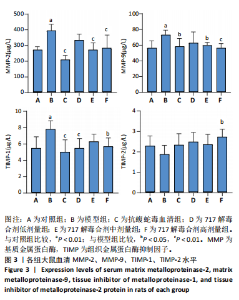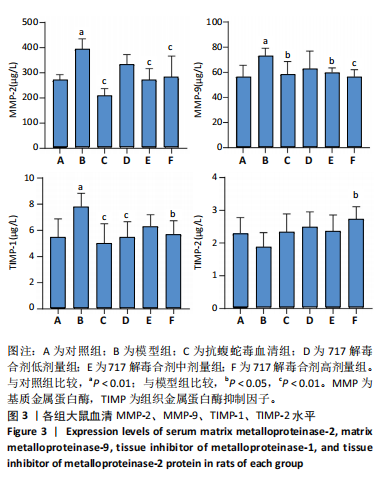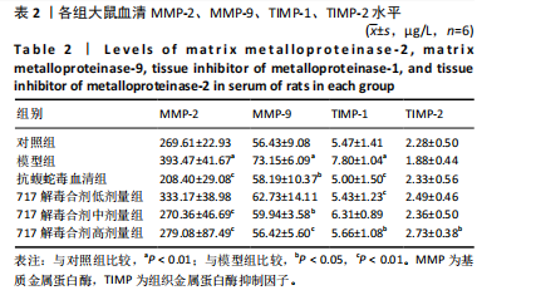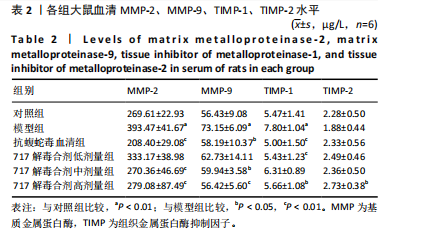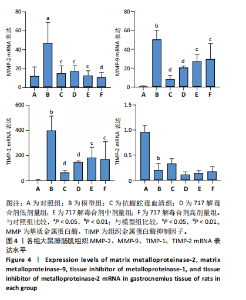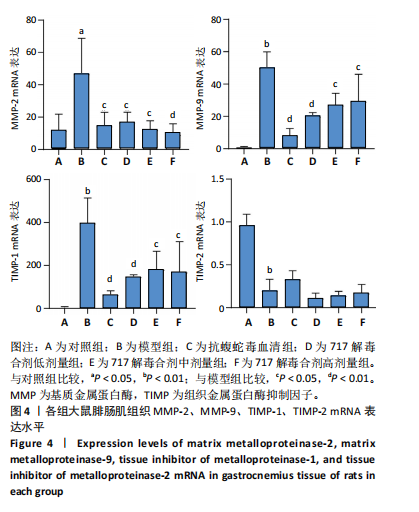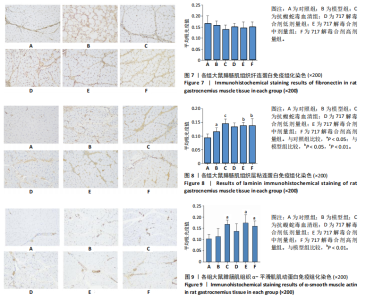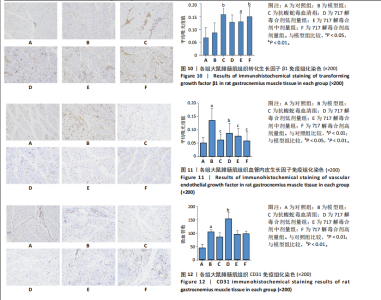Chinese Journal of Tissue Engineering Research ›› 2025, Vol. 29 ›› Issue (30): 6457-6465.doi: 10.12307/2025.906
Previous Articles Next Articles
717 Jiedu Decoction remodels homeostasis of extracellular matrix and promotes repair of local injured tissues in rats after Agkistrodon halys bite
Wang Wanchun1, 2, Yi Jun1, Yan Zhangren2, Yang Yue1, Dong Degang1, Li Yumei2
- 1Jiangxi University of Chinese Medicine, Nanchang 330004, Jiangxi Province, China; 2Affiliated Hospital of Jiangxi University of Chinese Medicine, Nanchang 330006, Jiangxi Province, China
-
Received:2024-09-25Accepted:2024-11-16Online:2025-10-28Published:2025-03-28 -
Contact:Li Yumei, MD, Affiliated Hospital of Jiangxi University of Chinese Medicine, Nanchang 330006, Jiangxi Province, China -
About author:Wang Wanchun, MD, Professor, Jiangxi University of Chinese Medicine, Nanchang 330004, Jiangxi Province, China; Affiliated Hospital of Jiangxi University of Chinese Medicine, Nanchang 330006, Jiangxi Province, China -
Supported by:National Natural Science Foundation of China (Regional Project), No. 81360288, 81960874 (to WWC); National Natural Science Foundation of China (Regional Project), No. 82260937 (to DDG); Jiangxi Natural Science Foundation (Key Project), No. 20202ACB206010 (to WWC); First Batch Science and Technology Innovation Team Funding Project of Jiangxi University of Chinese Medicine, No. CXTD22009 (to WWC); Jiangxi Province 2023 Graduate Innovation (Special Fund Project), No. YC2023-B230 (to LYM)
CLC Number:
Cite this article
Wang Wanchun, , Yi Jun, Yan Zhangren, Yang Yue, Dong Degang, Li Yumei. 717 Jiedu Decoction remodels homeostasis of extracellular matrix and promotes repair of local injured tissues in rats after Agkistrodon halys bite[J]. Chinese Journal of Tissue Engineering Research, 2025, 29(30): 6457-6465.
share this article
Add to citation manager EndNote|Reference Manager|ProCite|BibTeX|RefWorks
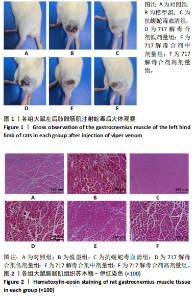
2.1 实验动物数量分析 选取72只SD大鼠随机分成6组:对照组8只、模型组16只、抗蝮蛇毒血清组12只、717解毒合剂低剂量组12只、717解毒合剂中剂量组12只、717解毒合剂高剂量组12只,在造模过程中死亡12只,其中模型组6只,717解毒合剂低剂量组3只,717解毒合剂中、高剂量组及抗蝮蛇毒血清组各1只,主要是由于蝮蛇伤模型对大鼠脏器损伤严重,以及蝮蛇毒含有复杂的毒素成分,对大鼠的生理机制有很大的冲击。最终存活并取材共60只。 2.2 一般情况观察 大鼠造模成功标志:大鼠未死亡,只限中毒症状,注射后3 min左右局部组织变为青色,行走不利,个别大鼠有躁狂症状,注射后1 h左右局部变为暗紫色,肿硬,甚则水肿、水疱,行动迟缓。取样前观察大鼠局部情况并拍摄照片,可见模型组局部组织肿胀、起水疱,创面色紫暗、溃烂并渗出。抗蛇毒血清组及717解毒合剂中、高剂量组局部肿胀、溃烂程度较模型组有所减轻,创面缩小,颜色暗红,见图1。 2.3 各组大鼠腓肠肌组织病理学变化 苏木精-伊红染色结果显示对照组肌肉组织结构完整,排列整齐,肌细胞间隙正常,无出血,无炎细胞浸润;模型组肌肉组织结构紊乱,肌细胞肿胀、坏死,肌细胞间隙变大,其间有大量炎细胞浸润,并可见明显的出血;抗蝮蛇毒血清组肌细胞结构正常,炎性浸润及出血现象明显减轻;717解毒合剂低剂量组肌细胞损伤减轻,炎细胞浸润减少,但仍可见散在的出血;717解毒合剂中、高剂量组肌细胞损伤进一步减轻,肌肉结构大致正常,炎性浸润及出血较模型组明显减轻,见图2。 2.4 各组大鼠基质金属蛋白酶、TIMPs蛋白及mRNA表达水平 与对照组相比,模型组血清基质金属蛋白酶2、基质金属蛋白酶9、TIMP-1水平均升高(P < 0.01),TIMP-2水平无显著差异(P > 0.05)。与模型组相比,717解毒合剂低剂量组血清TIMP-1水平降低(P < 0.01),717解毒合剂中剂量组血清基质金属蛋白酶2、基质金属蛋白酶9水平降低(P < 0.05或P < 0.01),抗蝮蛇毒血清组和717解毒合剂高剂量组血清基质金属蛋白酶2、基质金属蛋白酶9、TIMP-1水平均降低(P < 0.05或P < 0.01),且717解毒合剂高剂量组TIMP-2水平升高(P < 0.05),见表2,图3。 与对照组相比,模型组腓肠肌中基质金属蛋白酶2、基质金属蛋白酶9和TIMP-1 mRNA表达均升高(P < 0.05或P < 0.01),TIMP-2 mRNA表达降低(P < 0.01)。与模型组相比,抗蛇毒血清组及717解毒合剂各剂量组腓肠肌中基质金"
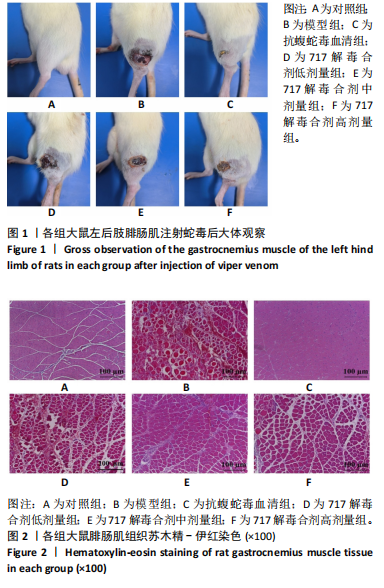
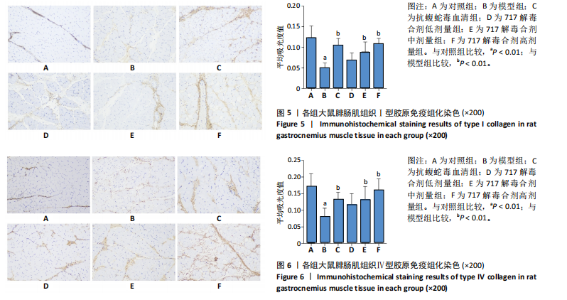
上述结果表明,抗蝮蛇毒血清和717解毒合剂能抑制蝮蛇伤大鼠基质金属蛋白酶2、基质金属蛋白酶9、TIMP-1蛋白及mRNA表达,但对TIMP-2蛋白及mRNA表达作用不显著。 2.5 各组大鼠腓肠肌中细胞外基质主要成分蛋白表达 免疫组化结果显示,Ⅰ型胶原、Ⅳ型胶原、纤连蛋白、层粘连蛋白等主要存在于细胞间隙,呈棕褐色,模型组稀疏淡染,对照组和各药物组染色较深、致密。模型组腓肠肌组织中Ⅰ型胶原、Ⅳ型胶原阳性表达显著低于对照组(P < 0.01),层粘连蛋白阳性表达显著高于对照组(P < 0.05),而纤连蛋白的表达无统计学差异(P > 0.05)。与模型组相比,抗蛇毒血清组Ⅰ型胶原、Ⅳ型胶原、层粘连蛋白阳性表达显著升高(P < 0.01),717解毒合剂中、高剂量组Ⅰ型胶原、Ⅳ型胶原、层粘连蛋白阳性表达明显升高(P < 0.05或P < 0.01),且呈剂量依赖性,而717解毒合剂低剂量组Ⅰ型胶原、Ⅳ型胶原、层粘连蛋白阳性表达及各组之间纤连蛋白的表达无统计学差异(P > 0.05),表明蝮蛇毒可致大鼠损伤局部细胞外基质蛋白降解,抗蝮蛇毒血清和717解毒合剂能促进细胞外基质蛋白合成,见图5-8。 2.6 各组大鼠腓肠肌中α-平滑肌肌动蛋白、转化生长因子β1蛋白表达 与对照组相比,模型组α-平滑肌肌动蛋白、转化生长因子β1蛋白表达无统计学差异(P > 0.05),而抗蛇毒血清组及717解毒合剂中、高剂量组α-平滑肌肌动蛋白、转化生长因子β1蛋白表达较模型组显著升高(P < 0.05或P < 0.01),表明抗蛇毒血清和717解毒合剂可促进蝮蛇伤大鼠损伤局部α-平滑肌肌动蛋白、转化生长因子β1蛋白的表达,见图9,10。 2.7 各组大鼠腓肠肌组织血管新生情况 与对照组相比,模型组血管内皮生长因子蛋白表达升高(P < 0.01),抗蝮蛇毒血清组及717解毒合剂各剂量组可抑制蝮蛇伤大鼠血管内皮生长因子蛋白表达(P < 0.05或P < 0.01),且呈剂量相关性,见图11。CD31免疫组化显示,与对照组相比,模型组阳性微血管数目升高(P < 0.01),与模型组相比,717解毒合剂低剂量组微血管数目升高(P < 0.01),而抗蝮蛇毒血清组及717解毒合剂中、高剂量组微血管数目无显著差异(P > 0.05),见图12。"
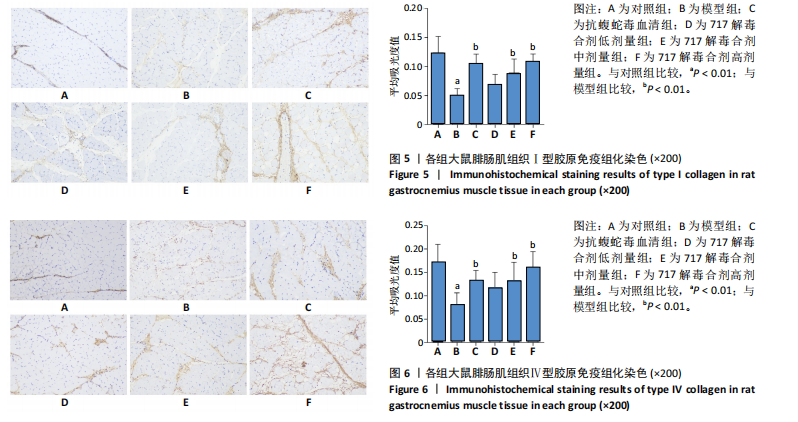
| [1] 朱铭金,钟吉富,何光荣.江西蝮蛇咬伤流行病学及预防对策研究[J].中国民族民间医药,2010,19(3):94-96. [2] 吴佳丽,潘俊卿,胡香君,等.南昌地区蝮蛇咬伤致急性肝损伤的临床特点及危险因素分析[J].蛇志,2021,33(3):257-260. [3] RALPH R, FAIZ MA, SHARMA SK, et al. Managing snakebite. BMJ. 2022; 376:e057926. [4] 颜时姣,胡燕兰,王选岩,等.中国蛇伤诊疗现状与展望[J].中华急诊医学杂志,2024,33(3):281-285. [5] GOPAL G, SELVARAJ H, VENKATARAMANAN SK, et al. Systematic review and meta-analysis on the efficacy of Indian polyvalent antivenom against the Indian snakes of clinical significance. Arch Toxicol. 2024; 98(2):375-393. [6] 董德刚,宋梅,邓中平,等.植物药抗蛇毒局部毒性效应作用与机制研究进展[J].中国药理学通报,2020,36(7):907-911. [7] 邓孝露,陈小雄,罗丽,等.蛇咬伤致急性肾损伤危险因素分析[J].临床急诊杂志,2024,25(8):428-432. [8] 李玉梅,杨悦,易军,等.毒蛇咬伤后相关并发症的研究进展[J].中国比较医学杂志,2024,34(5):144-151. [9] 黄宜谋,罗焕荣,王杰伟.竹叶青蛇咬伤51例临床分析[J].岭南急诊医学杂志,2021,26(1):77-79. [10] RATHORE AS, KUMAR R, TIWARI OS. Recent advancements in snake antivenom production. Int J Biol Macromol. 2023;240:124478. [11] 李玉梅,杨悦,易军,等.细胞外基质:毒蛇咬伤致局部组织损伤的治疗新靶点[J].中国病理生理杂志,2024,40(7):1324-1330. [12] STRAESSER M, KESHAVARZ B, BORISH L, et al. α-Gal on Crotalidae-polyvalent Fab antivenom (CroFab): Investigating the relevance to immediate hypersensitivity reactions. J Allergy Clin Immunol Pract. 2021;9(2):1015-1017.e1. [13] 姚学强,董朕,李江,等.动物毒液的抗菌活性研究进展[J].中兽医医药杂志,2024,43(3):43-47. [14] 田雯,周发伟,杨美玲,等.纤维蛋白降解产物和D-二聚体与毒蛇咬伤患者病情严重程度的相关性[J].中国急救复苏与灾害医学杂志,2024,19(7):947-951. [15] SAMPAT GH, HIREMATH K, DODAKALLANAVAR J, et al. Unraveling snake venom phospholipase A2: an overview of its structure, pharmacology, and inhibitors. Pharmacol Rep. 2023;75(6):1454-1473. [16] YUSUF AJ, BUGAJE AI, SADIQ M, et al. Exploring the inhibitory potential of phytochemicals from Vernonia glaberrima leaves against snake venom toxins through computational simulation and experimental validation. Toxicon. 2024;247:107838. [17] 黄国亮,覃晓波,吴雪,等.一次性覆盖式负压封闭引流技术在福建竹叶青属毒蛇咬伤救治中的应用[J].蛇志,2022,34(2):145-149. [18] 陈俊,董德刚,严张仁,等.莲花解毒汤治疗五步蛇咬伤40例临床观察[J].北京中医药大学学报,2020,43(12):1053-1057. [19] 董德刚,杨悦,郑向龙,等.717解毒合剂通过NETs-CYR61/CCN1信号通路对蝮蛇咬伤大鼠局部组织损伤修复作用[J].中国药学杂志, 2024,59(2):151-160. [20] 董德刚,宋梅,陈俊,等.717解毒合剂对蝮蛇毒所致局部组织损伤的保护作用与机制研究[J].中国中西医结合急救杂志,2021,28(2): 203-208. [21] 张允申,方勇,陈海东,等.蝮蛇咬伤中医治疗优化方案的疗效评价[J].云南中医药大学学报,2024,47(1):33-39. [22] THEOCHARIS AD, MANOU D, KARAMANOS NK. The extracellular matrix as a multitasking player in disease. FEBS J. 2019;286(15):2830-2869. [23] ABIOLA J, BERG AM, AIYELAAGBE O, et al. Dabsylated Bradykinin Is Cleaved by Snake Venom Proteases from Echis ocellatus. Biomedicines. 2024;12(5):1027. [24] 曾晓艳,林雅丽,刘应蛟,等.五步蛇蛇毒对脂多糖诱导的RAW264.7巨噬细胞炎症反应的影响研究[J].中南药学,2022,20(8): 1820-1824. [25] 黄小梅,支慧,陈浩,等.皖南蝮蛇毒抑瘤组分-Ⅰ对胃癌MKN-28细胞增殖、迁移及凋亡的影响[J].中国临床药理学与治疗学, 2024,29(3):270-276. [26] 胡延星,李亚梅,杜义博,等.蛇毒抗肿瘤活性成分的研究进展[J].河北师范大学学报(自然科学版),2021,45(5):522-529. [27] 刘明明,李爱玲,修瑞娟.基质金属蛋白酶的研究进展[J].中国病理生理杂志,2018,34(10):1914-1920. [28] 肖曼琪,关哲哲,胡少聪,等.中华眼镜蛇毒致广西巴马小型猪坏死组织渗出液中的蛇毒成分分析[J].广西医科大学学报,2024, 41(8):1101-1110. [29] ESCALANTE T, RUCAVADO A, FOX JW, et al. Key events in microvascular damage induced by snake venom hemorrhagic metalloproteinases. J Proteomics. 2011;74(9):1781-1794. [30] SONAVANE M, ALMEIDA JR, RAJAN E, et al. Intramuscular Bleeding and Formation of Microthrombi during Skeletal Muscle Damage Caused by a Snake Venom Metalloprotease and a Cardiotoxin. Toxins (Basel). 2023;15(9):530. [31] CAVALCANTE JDS, DE ALMEIDA CAS, CLASEN MA, et al. A fingerprint of plasma proteome alteration after local tissue damage induced by Bothrops leucurus snake venom in mice. J Proteomics. 2022;253:104464. [32] WEBER GC, BUHREN BA, SCHRUMPF H, et al. Clinical Applications of Hyaluronidase. Adv Exp Med Biol. 2019;1148:255-277. [33] RUCAVADO A, NÚÑEZ J, GUTIÉRREZ JM. Blister formation and skin damage induced by BaP1, a haemorrhagic metalloproteinase from the venom of the snake Bothrops asper. Int J Exp Pathol. 1998;79(4):245-254. [34] GOMES A, DAS R, SARKHEL S, et al. Herbs and herbal constituents active against snake bite. Indian J Exp Biol. 2010;48(9):865-878. [35] HINZ B. Myofibroblasts. Exp Eye Res. 2016;142:56-70. [36] FRANGOGIANNIS N. Transforming growth factor-β in tissue fibrosis. J Exp Med. 2020;217(3):e20190103. [37] TAI Y, WOODS EL, DALLY J, et al. Myofibroblasts: Function, Formation, and Scope of Molecular Therapies for Skin Fibrosis. Biomolecules. 2021;11(8):1095. [38] NEVE A, CANTATORE FP, MARUOTTI N, et al. Extracellular matrix modulates angiogenesis in physiological and pathological conditions. Biomed Res Int. 2014;2014:756078. [39] GUTIÉRREZ JM, ESCALANTE T, RUCAVADO A, et al. A Comprehensive View of the Structural and Functional Alterations of Extracellular Matrix by Snake Venom Metalloproteinases (SVMPs): Novel Perspectives on the Pathophysiology of Envenoming. Toxins (Basel). 2016;8(10):304. [40] GUTIÉRREZ JM, RUCAVADO A, ESCALANTE T, et al. Unresolved issues in the understanding of the pathogenesis of local tissue damage induced by snake venoms. Toxicon. 2018;148:123-131. [41] RIVAS MERCADO E, NERI CASTRO E, BÉNARD VALLE M, et al. Disintegrins extracted from totonacan rattlesnake (Crotalus totonacus) venom and their anti-adhesive and anti-migration effects on MDA-MB-231 and HMEC-1 cells. Toxicol In Vitro. 2020;65:104809. [42] SCHÖNTHAL AH, SWENSON SD, CHEN TC, et al. Preclinical studies of a novel snake venom-derived recombinant disintegrin with antitumor activity: A review. Biochem Pharmacol. 2020;181:114149. [43] CASTANHEIRA LE, LOPES DS, GIMENES SNC, et al. Angiogenenic effects of BpLec, a C-type lectin isolated from Bothrops pauloensis snake venom. Int J Biol Macromol. 2017;102:153-161. |
| [1] | Lai Pengyu, Liang Ran, Shen Shan. Tissue engineering technology for repairing temporomandibular joint: problems and challenges [J]. Chinese Journal of Tissue Engineering Research, 2025, 29(在线): 1-9. |
| [2] | Zheng Rongfa, Mo Weibin, Huang Peng, Chen Junji, Liang Ting, Zi Fangyu, Li Guofeng. Effects of electroacupuncture on the expression of metabolic enzymes and autophagy genes in gastrocnemius muscle tissues of exercising rats [J]. Chinese Journal of Tissue Engineering Research, 2025, 29(6): 1127-1136. |
| [3] | Shui Jing, He Yu, Jiang Nan, Xu Kun, Song Lijuan, Ding Zhibin, Ma Cungen, Li Xinyi. Astrocytes regulate remyelination in central nervous system [J]. Chinese Journal of Tissue Engineering Research, 2025, 29(36): 7889-7897. |
| [4] | Zhang Xiaoyu, Wei Shanwen, Fang Jiawei, Ni Li. Prussian blue nanoparticles restore mitochondrial function in nucleus pulposus cells through antioxidation [J]. Chinese Journal of Tissue Engineering Research, 2025, 29(34): 7318-7325. |
| [5] | Hu Shujuan, Liu Dang, Ding Yiting, Liu Xuan, Xia Ruohan, Wang Xianwang. Ameliorative effect of walnut oil and peanut oil on atherosclerosis [J]. Chinese Journal of Tissue Engineering Research, 2025, 29(30): 6482-6488. |
| [6] | Xu Zhi, Chen Yundong, Sun Yujie, Gong Xiaonan, Li Yuwan. Data of spinal osteosarcoma patients in United States based on SEER database: construction and validation of a prediction model for treatment outcomes and prognosis [J]. Chinese Journal of Tissue Engineering Research, 2025, 29(30): 6583-6590. |
| [7] | Chen Jiayong, Tang Meiling, Lu Jianqi, Pang Yan, Yang Shangbing, Mao Meiling, Luo Wenkuan, Lu Wei. Causal association between metabolites and sarcopenia: a big data analysis of genome-wide association studies in the European population [J]. Chinese Journal of Tissue Engineering Research, 2025, 29(29): 6369-6380. |
| [8] | Song Yuting, Wen Chunlei, Li Yi, Bai Xue, Gao Hong, Hu Tingju, Wang Zijun, Yan Xu. Effects of myocardial extracellular matrix remodeling on connexin 43 and its Ser368 phosphorylation and electrical conduction [J]. Chinese Journal of Tissue Engineering Research, 2025, 29(29): 6212-6218. |
| [9] | Sun Yahui, Wang Yufeng, Guo Chao, Yao Junjie, Ji Yuanyuan, Li Zhongxu, Lou Huijuan, Jiang Jinglei, Sun Yiping, Xu Jing, Cong Deyu. Effect of massage on extracellular matrix collagen deposition in skeletal muscle of type 2 diabetic rats [J]. Chinese Journal of Tissue Engineering Research, 2025, 29(26): 5549-5555. |
| [10] | Zhao Zhenning, , , Li Kaiying, , , Yang Nan, , , Sun Wenjing, , , Wei Xiaoge, , , Mu Jing, Ma Huisheng, , . Regulatory mechanism of electroacupuncture on hypothalamic-pituitary-testicular axis in oligospermic rats [J]. Chinese Journal of Tissue Engineering Research, 2025, 29(26): 5563-5571. |
| [11] | Ji Yaqiong, Ning Zhongping. Protective effect of paeoniflorin on angiotensin II-induced fibrosis in cardiac fibroblasts [J]. Chinese Journal of Tissue Engineering Research, 2025, 29(25): 5382-5389. |
| [12] | Zhou Lijun, Zhang Keyuan, Xu Feihu, Wang Xi, Yu Li, Dong Shiming, Xu Junyu, Guo Yufeng, Ma Hairong, Ding Hong. Effect and mechanism of circular RNA SEC24A on proliferation and apoptosis of synovial fibroblasts in osteoarthritis [J]. Chinese Journal of Tissue Engineering Research, 2025, 29(24): 5086-5092. |
| [13] | Yang Jun, Yin Peng, Zheng Zhonghua. Mechanism of stachydrine-induced autophagy in improving atherosclerosis in high-fat-fed mice [J]. Chinese Journal of Tissue Engineering Research, 2025, 29(24): 5140-5147. |
| [14] | Deng Yiran, Wang Xianliang, Li Dandan. Meta-analysis of exercise intervention on cardiopulmonary function in stroke patients [J]. Chinese Journal of Tissue Engineering Research, 2025, 29(24): 5203-5211. |
| [15] | Wang Dan, Zhu Xiaojun, Li Zhicheng, Li Na. Construction of tissue engineered urethra by combining acellular matrix with exosomes in small intestinal submucosa [J]. Chinese Journal of Tissue Engineering Research, 2025, 29(23): 4907-4914. |
| Viewed | ||||||
|
Full text |
|
|||||
|
Abstract |
|
|||||
